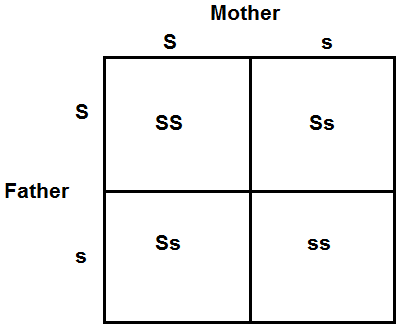Autosomal Recessive Inheritance Calculator

The autosomal recessive inheritance calculator calculates the risk that a child has of developing the disease, developing the trait, or being completely unaffected and normal.
Autosomal recessive diseases are diseases in which a child receives 2 abnormal copies of a gene from each parent.
The reason it is called recessive is because both parents must each contribute a copy of an abnormal gene in order for the chld to get the disease. It doesn't dominant where just one parent has it while the other is unaffected and the child can get it. Both parents must contribute each contribute a faulty gene for the child to get the disease.
Autosomes are the first 22 pairs of chromosomes that exist in a human being's DNA. A healthy, normal human being has 46 chromosomes. The first 22 pairs of chromosomes (composed of 44 chromosomes) are referred to autosomes, or non-sex chromosomes. The last pair are the sex chromosomes. Human beings have 2 sex chromosomes.
Defects in any of the autosomes of the human body can cause disease, as is evidenced by autosomal recessive disorders.
Many disorders are autosomal recessive disorders including sickle cell disease, cystic fibrosis, thalassemia, and Tay Sachs disease.
Autosomal recessive diseases are diseases in which both parents must each contribute an abnormal gene in order for a child to have the disease. If only one parent has the disease or trait and the other doesn't, the child has no chance of developing the disease. The child, however, can have the trait if just one parent is affected with an abnormal gene. However, to have the actual disease, each parent must either have the abnormal gene either in the form of the disease or trait.
So now we'll go through each of the possibilities of how breeding can go.
If neither parent has the trait or disease, the child has no chance of developing the disease or trait.
If one parent has the trait and the other parent is normal, the child has a 0% chance of developing the disease. The child, however, has a 50% chance of having the trait and being a carrier of the disease. And there is a 50% chance the child will be completely unaffected.
If one parent has the trait and the other parent is disease, the child has a 50% of developing the disease and a 50% of being a carrier of the disease. The child will be affected with either disease or trait.
If both parents have the trait, the child has a 25% chance of developing the disease, a 50% chance of being a carrier of the disease, and a 25% chance of being completely unaffected.
If both parents have the disease, the child has a 100% chance of developing the disease.
That exhausts all the possibilities that exist for autosomal recessive disorders.
Genetic testing is available to determine if parents carry certain traits and are at risk for conceiving a child with an autosomal recessive disorder. However, due to many factors such as unplanned pregnancies, this often isn't sought which is why many children are still born with these autosomal recessive disorders. But genetic testing is widely available and is encouraged for parents in the pre-planning phase for conception to allow for the healthiest, disease-free child.
Despite genetic testing being widely available, autosomal recessive disorders are still very prevalent.
Sickle cell disease is a disease in which a person's red blood cells are abnormally shaped, which make it harder for the red blood cells to travel through the blood vessels. This can cause blood to clump together and cause sickle cell crises, which can lead to excruciating pain. Sickle cell is a blood disorder of abnormal hemoglobin. In order of having normal hemoglobin A, a person has hemoglobin S.
Thalassemia is another blood disorder in which abnormal hemoglobin is produced. It is rarer than sickle cell disease, but, just like sickle cell disease, is a lifelong illness that requires constant medical watch and reduces quality of life.
Cystic fibrosis is a condition in which a person has abnormally thick mucus and primarily affects the lungs and digestive system. This mucus can make it hard for a person with cystic fibrosis to breathe and the GI involvement can lead to indigestion and malabsorption of food. It affects about 30,000 people in the United States and about 70,000 worldwide.
Tay Sach's disease is a disease in which a person lacks a vital enzyme, hexosaminidase (Hex-A), which is an enzyme need by the body to break down a fatty waste substance found in brain cells. Without it, the waste products accumulate in the brain and causes progressive damage that leads to death. It is a relatively rare condition but is fatal.
There are many more autosomal recessive disorders.
The point is, with proper education, awareness of testing can be done to help decrease these diseases that can plague our children.
Related Resources
Autosomal Dominant Calculator
Naegele's Rule Calculator
Bartholomew's Rule of Fourths Calculator
